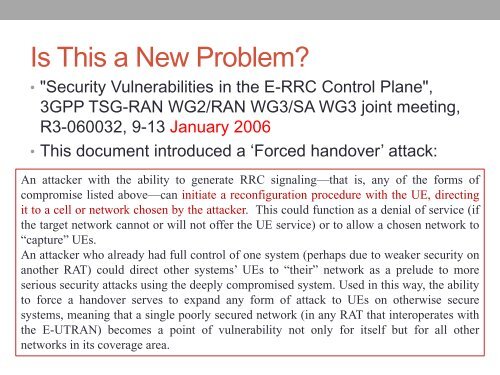LTE REDIRECTION
e7JPpYT
e7JPpYT
Create successful ePaper yourself
Turn your PDF publications into a flip-book with our unique Google optimized e-Paper software.
Is This a New Problem?<br />
• "Security Vulnerabilities in the E-RRC Control Plane",<br />
3GPP TSG-RAN WG2/RAN WG3/SA WG3 joint meeting,<br />
R3-060032, 9-13 January 2006<br />
• This document introduced a „Forced handover‟ attack:<br />
An attacker with the ability to generate RRC signaling—that is, any of the forms of<br />
compromise listed above—can initiate a reconfiguration procedure with the UE, directing<br />
it to a cell or network chosen by the attacker. This could function as a denial of service (if<br />
the target network cannot or will not offer the UE service) or to allow a chosen network to<br />
“capture” UEs.<br />
An attacker who already had full control of one system (perhaps due to weaker security on<br />
another RAT) could direct other systems’ UEs to “their” network as a prelude to more<br />
serious security attacks using the deeply compromised system. Used in this way, the ability<br />
to force a handover serves to expand any form of attack to UEs on otherwise secure<br />
systems, meaning that a single poorly secured network (in any RAT that interoperates with<br />
the E-UTRAN) becomes a point of vulnerability not only for itself but for all other<br />
networks in its coverage area.

















